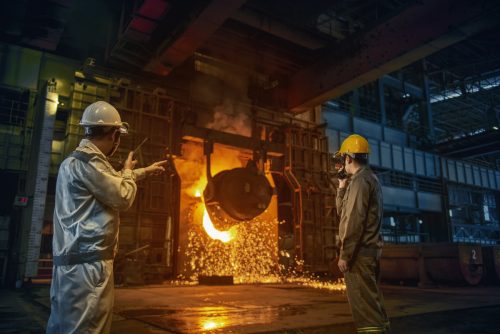Comparing EAF and BOF ingots has been a topic of great interest lately. These are two widely used methods in the steel production process worldwide. Follow this article to gain a better understanding of these two methods.
Learn more: What is steel billet?
An EAF ingot is one of the primary steel production technologies in the field of metal technology. The main raw material for this method is scrap steel. Thanks to the EAF ingot steel production technology, steel becomes almost 100% recyclable. The advantages of this technology include low cost, flexibility in production, and specialization in various fields.

A BOF ingot is a steel production technology using about 67% raw materials such as iron ore, limestone, and coke. In this process, pig iron and scrap steel are melted and converted into steel through the oxidizing action of oxygen blown into the molten metal under basic slag.
The Basic Oxygen Furnace (BOF) used for steel production undergoes several important steps:
Step 1: Iron ore and limestone are processed, dried, finely ground, and filtered during the sintering process. During this time, coal is also roasted in the furnace to produce pure coke.
Step 2: The product from step 1 is then fed into the blast furnace, also known as the high furnace, at a specific ratio. Hot air is supplied to the furnace to create the reduction reaction of oxide, recovering iron. The temperature in the furnace can reach up to 2200°C.
Step 3: Slag, a resource produced from the iron smelting process, often containing impurities from limestone, is ready to be used as a material for cement and sugar production. The molten iron at this stage is ready to enter the BOF furnace for steel production.
Step 4: Molten iron and a certain amount of scrap steel are introduced into the BOF furnace at a specific ratio. At this point, pure oxygen is blown into the furnace from above through oxygen burners at twice the speed of sound, aiding in the oxidation of carbon, manganese, and silicon. This process generates a large amount of heat, melting the scrap steel. The oxidation removes impurities from the iron and produces refined steel.
Step 5: Refined steel is poured into containers, and chemical composition and temperature are adjusted according to specific requirements for each steel grade before entering the continuous casting stage to form raw products.
With large capacity, BOF furnaces can produce from 300 to 400 tons of steel in 30 minutes. This process ensures that the steel products meet high standards of quality and performance in industrial applications.
Reference
The above information provides details about EAF and BOF ingots shared by Stavian. We hope readers now have a clearer understanding of these two modern production methods.
Address
Website: https://stavianmetal.com
Email: info@stavianmetal.com
